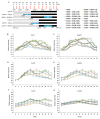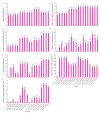Flowering and Runnering of Seasonal Strawberry under Different Photoperiods Are Affected by Intensity of Supplemental or Night-Interrupting Blue Light
- PMID: 38337908
- PMCID: PMC10857185
- DOI: 10.3390/plants13030375
Flowering and Runnering of Seasonal Strawberry under Different Photoperiods Are Affected by Intensity of Supplemental or Night-Interrupting Blue Light
Abstract
The strawberry (Fragaria × ananassa Duch.) "Sulhyang" is a typical seasonal flowering (SF) strawberry that produces flower buds in day lengths shorter than a critical limit (variable, but often defined as <12 h). There is a trade-off between photoperiod-controlled flowering and gibberellin (GA) signaling pathway-mediated runnering. Some related genes (such as CO, FT1, SOC1, and TFL1) participating in light signaling and circadian rhythm in plants are altered under blue light (BL). Sugars for flowering and runnering are mainly produced by photosynthetic carbon assimilation. The intensity of light could affect photosynthesis, thereby regulating flowering and runnering. Here, we investigated the effect of the intensity of supplemental blue light (S-BL) or night-interrupting blue light (NI-BL) in photoperiodic flowering and runnering regulation by applying 4 h of S-BL or NI-BL with either 0, 10, 20, 30, or 40 μmol·m-2·s-1 photosynthetic photon flux density (PPFD) in a 10 h short-day (SD10) (SD10 + S-BL4 or + NI-BL4 (0, 10, 20, 30, or 40)) or 14 h long-day (LD14) conditions (LD14 + S-BL4 or + NI-BL4 (0, 10, 20, 30, or 40)). Approximately 45 days after the photoperiodic light treatment, generally, whether S-BL or NI-BL, BL (20) was the most promotive in runnering, leading to more runners in both the LD and SD conditions. For flowering, except the treatment LD14 + S-BL, BL (20) was still the key light, either from BL (20) or BL (40), promoting flowering, especially when BL acted as the night-interrupting light, regardless of the photoperiod. At the harvest stage, larger numbers of inflorescences and runners were observed in the LD14 + NI-BL4 treatment, and the most were observed in the LD14 + NI-BL (20). Moreover, the SD10 + NI-BL4 was slightly inferior to the LD14 + NI-BL4 in increasing the numbers of inflorescences and runners, but it caused earlier flowering. Additionally, the circadian rhythm expression of flowering-related genes was affected differently by the S-BL and NI-BL. After the application of BL in LD conditions, the expression of an LD-specific floral activator FaFT1 was stimulated, while that of a flowering suppressor FaTFL1 was inhibited, resetting the balance of expression between these two opposite flowering regulators. The SD runnering was caused by BL in non-runnering SD conditions associated with the stimulation of two key genes that regulate runner formation in the GA pathway, FaGRAS32 and FaGA20ox4. In addition, the positive effects of BL on enhancing photosynthesis and carbohydrate production also provided an abundant energy supply for the flowering and runnering processes.
Keywords: GA pathway; carbohydrate accumulation; circadian rhythm; light intensity; photoperiodic response; photosynthetic efficiency; seasonal flowering; supplemental or night-interrupting blue light.
Conflict of interest statement
The authors declare no conflicts of interest.
Figures











Similar articles
-
Complex Signaling Networks Underlying Blue-Light-Mediated Floral Transition in Plants.Plants (Basel). 2025 May 20;14(10):1533. doi: 10.3390/plants14101533. Plants (Basel). 2025. PMID: 40431098 Free PMC article. Review.
-
Both the Positioned Supplemental or Night-Interruptional Blue Light and the Age of Leaves (or Tissues) Are Important for Flowering and Vegetative Growth in Chrysanthemum.Plants (Basel). 2024 Oct 14;13(20):2874. doi: 10.3390/plants13202874. Plants (Basel). 2024. PMID: 39458821 Free PMC article.
-
The flowering of SDP chrysanthemum in response to intensity of supplemental or night-interruptional blue light is modulated by both photosynthetic carbon assimilation and photoreceptor-mediated regulation.Front Plant Sci. 2022 Sep 16;13:981143. doi: 10.3389/fpls.2022.981143. eCollection 2022. Front Plant Sci. 2022. PMID: 36186037 Free PMC article.
-
Blue Light Supplemented at Intervals in Long-Day Conditions Intervenes in Photoperiodic Flowering, Photosynthesis, and Antioxidant Properties in Chrysanthemums.Antioxidants (Basel). 2022 Nov 22;11(12):2310. doi: 10.3390/antiox11122310. Antioxidants (Basel). 2022. PMID: 36552519 Free PMC article.
-
Photoperiodic and lighting treatments for flowering control and its genetic regulation in sugarcane breeding.Heliyon. 2024 Mar 26;10(7):e28531. doi: 10.1016/j.heliyon.2024.e28531. eCollection 2024 Apr 15. Heliyon. 2024. PMID: 38586380 Free PMC article. Review.
Cited by
-
Influence of photoperiod on endogenous phytohormone levels and cadmium-related gene expression in Sedum alfredii.Plant Signal Behav. 2025 Dec;20(1):2544317. doi: 10.1080/15592324.2025.2544317. Epub 2025 Aug 12. Plant Signal Behav. 2025. PMID: 40794288 Free PMC article.
-
Complex Signaling Networks Underlying Blue-Light-Mediated Floral Transition in Plants.Plants (Basel). 2025 May 20;14(10):1533. doi: 10.3390/plants14101533. Plants (Basel). 2025. PMID: 40431098 Free PMC article. Review.
-
The role of light in regulating plant growth, development and sugar metabolism: a review.Front Plant Sci. 2025 Jan 7;15:1507628. doi: 10.3389/fpls.2024.1507628. eCollection 2024. Front Plant Sci. 2025. PMID: 39840366 Free PMC article. Review.
References
-
- Staudt G. Taxonomic studies in the genus Fragaria typification of Fragaria species known at the time of Linnaeus. Can. J. Bot. 1962;40:869–886. doi: 10.1139/b62-081. - DOI
-
- Stauct G. The species of Fragaria, their taxonomy and geographical distribution; Proceedings of the International Strawberry Symposium 265; Cesena, Italy. 22–27 May 1988; pp. 23–34.
-
- Darrow G.M. The Strawberry. 1966. [(accessed on 30 October 2022)]. Available online: https://www.cabdirect.org/cabdirect/abstract/19680300487.
-
- Finn C.E., Retamales J.B., Lobos G.A., Hancock J.F. The Chilean strawberry (Fragaria chiloensis): Over 1000 years of domestication. HortScience. 2013;48:418–421. doi: 10.21273/HORTSCI.48.4.418. - DOI
LinkOut - more resources
Full Text Sources
Research Materials

